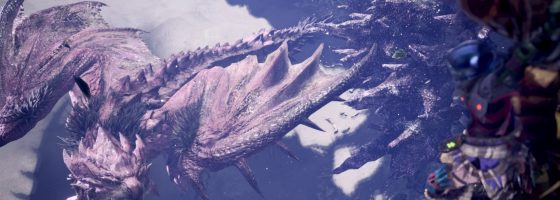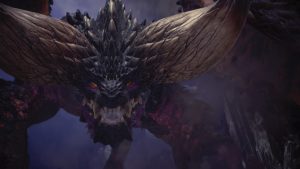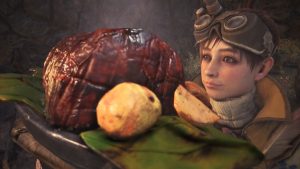Capcom remains a part of the ever-shrinking club of developers from the 80’s still in business. The studio may have never made a platform, but its portfolio includes some of the most memorable franchises around — Mega Man, Resident Evil, Street Fighter, and Devil May Cry. But there is one game that for the longest time in the US remained a niche hit… until it became the best selling title from Capcom of all time in 2018. For today, we’re going to take a closer look at how Monster Hunter went from having a cult success to having a global one.
The Hunt Begins:
The very first Monster Hunter was released on the PlayStation 2 in the US and Japan in 2004. We’ll be talking more about the gameplay loop of the franchise later in this post, and to keep things straightforward, we’re going to be ignoring the side story, or spinoff, games.
From the offset, the basic structure of the game was set. You played as a hunter in a world where monsters roamed the land, and it was up to you to hunt and fight them. In the original version, you had to choose what kind of hunter you were: close or long-ranged, and then that would let you pick from different weapons of that category.
Now, this is where things get a little confusing. Following the release of Monster Hunter, Capcom would then begin a trend of making remastered versions with more content under the suffix “G” in Japan. These versions would always add in more content — namely in the form of expert/end-game hunts for players to do. Outside of Japan, these versions would go under the “Freedom” suffix.
Around this time, Sony began the now infamous work of making their own competing handheld platform with the PlayStation Portable or PSP. While it did not gain traction in the US (and that story could be its own article), it did sell better outside and became the home for the enhanced editions of the Monster Hunter franchise.
Japan vs. US
Monster Hunter up until World was considered one of the main reasons to own a PSP, as each remastered version was only released on it. Monster Hunter’s split popularity could be distilled down into the differences between the US and Japanese audiences.
It has been an established trend that handheld games have always been more popular in Japan. The portability of the platform combined with smaller living areas were a factor. This also played a role in one of the more popular features of the series — 4 player coop mode. Due to the limitations of the PS2, the first couple of Monster Hunter games lacked multiplayer until they were released on the PSP.
Due to the higher population density of Japan, the game thrived with ad-hoc multiplayer, where local players would sync up their PSPs to play with each other. The game also featured new events that would be downloaded to the system.
This kind of multiplayer was very important to Capcom and fans, and why despite starting on consoles, there was always a portable version of the game available up until world.
The official third entry in the series: Monster Hunter Tri was special, as it was the first game to be released originally on the Wii instead of on a PlayStation platform. Unfortunately, the Wii wasn’t exactly the best console for third party titles, and both the PSP and 3DS remasters sold better.
With the PSP officially dead, the fourth main game was released exclusively on the 3DS, and while it had good sales, they weren’t anything special. Even though the portability of the franchise was one of the strongest elements, it also led to many of the pain points that turned off new fans. Before we talk about them, let’s talk about the good and what helped attracted fans to the series to begin with.
A Monstrous Progression Curve
The Monster Hunter franchise has built itself on top of the progression curve and gameplay loop of ARPG design – fight monsters, get loot, grow more powerful, and repeat. While that is nothing new to gamers regardless of platform, it’s how the series achieves this loop that gives its appeal.
The monsters are all unique creatures and are akin to bosses in other games. Each one has a random pattern to fighting it, behaviors to watch out for, and can make use of the environment to give you the slip. Fighting them is all about reading what they’re about to do and get in hits when you can. By attacking specific parts of the monster, you can chip off parts of them to weaken them or be used later. Defeating a monster requires you to either kill it or use traps to try and capture it for more loot.
Besides the thrill of the hunt, the reason you’re going after these monsters is that all progression in the game is equipment-based. There is no leveling in the Monster Hunter series — you will never be able to upgrade your health or stamina and so on.
Instead, your gear defines everything about your character, and the only way to get better gear is to craft it. Each game in the series features an extensive gear tree, where you’ll use the materials gain from fighting to craft and upgrade the weapons you want. The thrill of getting new equipment is present in every ARPG, but Monster Hunter is the only one that really makes you work for it.
And keeping with that theme, Monster Hunter also goes in a different direction with its combat.
14 Flavors of Fighting
When it comes to ARPG design, combat is always distilled down into two types — ranged and melee. While there are differences in terms of range or speed, swinging a mace is just like swinging a sword, or a bow is like a gun.
Monster Hunter, however, gets creative. Each one of the game’s (currently) 14 weapon types are completely different in terms of usage. The developers go as far as even having different UIs based on the weapon you use. You could wield a katana and be about powerful long slashes, you could use an axe that morphs into a giant sword, or in my case, use a war horn that I beat monsters with and then play songs to buff myself.
And again, every weapon type has its own progression gear for upgrades and different versions of them. It can take dozens of hours to learn, master, and upgrade one weapon, let along 13 others. The reason why you’re going to keep playing is how the developers approach the “end” game.
A New, New Game Plus
When we talk about new game plus or post-game content, it’s usually meant to either keep playing the game as is or something a little extra for people who finish the game. Monster Hunter however is built entirely on its end-game content.
Earlier I mentioned that every Monster Hunter game got a remastered version, and one of the main things added comes in the form of post-game expert content. The main story of each game is essentially a tutorial for what’s to come. After the final story mission, which usually involves fighting an extra-large monster, you are then given access to new missions and challenges.
A harder version of the game essentially becomes unlocked — remixing all the areas in the game to feature harder enemies, different versions of monsters, and new loot and materials to find. Most importantly, this is when the developers unlock brand new, and extra hard monsters. Some of these are expert variants of the ones already in the game, sometimes they’re original creatures, or they could be returning fan favorites from previous games.
This is also when the quest for more gear kicks off, with the progression tree for all the armor and weapons extending with new features, appearances, and options. With the recently released Iceborne expansion (and coming to the PC in January) things are going to continue to grow with new monsters and further increasing the progression curve.
All this sounds amazing, and I’m sure some of you are wondering why you’ve never heard of this series before, but what made the series a cult hit on handhelds also held it back for the longest time.
A Constrained Hunt
Despite the series being released on consoles, fans knew that the best versions of the game were on the handhelds, and this became a factor with the design of the titles.
The first issue had to do with camera controls. Both the PSP and 3DS did not have a second analog stick (the 3DS had a purchasable attachment), this meant the games were designed around using the face buttons for camera control. Basic features like tilting the camera, lock-on, and just the general functionality of a 3D camera was not here.
Being on the handhelds also meant a severe downgrade in terms of the engine. As the series grew in terms of scope and graphical power, they were always held back by the 3DS and PSP. Loading times were a huge problem.
The reason was that the game loaded each zone in a biome one at a time, and another load when you go from the hub to a mission. If you had to switch zones, you had to wait for the game to load that area. This became such an issue that later entries would allow players to download assets onto the PSP memory stick to help reduce the load times off the disc.
Another problem was getting new players invested in the franchise to begin with. Not only did newcomers have to buy a PSP or 3DS for the best version of the respective entry, but the series began to ignore playability and onboarding. Since it had a cult fanbase who would buy every entry, the developers knew that the fans already figured out how to play the game.
This meant that documentation and tutorials were kept minimum, which is not good for someone trying to get into the game.
While we’ve only described things at the basic level, there is a lot that goes into learning a monster hunter game and its subsystems. Not only that, but convincing new players that there is more to each game beyond the story and grinding proved to be difficult alongside the confusing gameplay.
And that was the story of Monster Hunter for over a decade — a niche series with a hardcore fanbase that would get any platform to play the next entry. But in 2018, Capcom and the development team took a gamble on going big with Monster Hunter World, and it paid off.
Taking Over the World
Monster Hunter World’s development began in 2014; one year after the release of the PS4 and Xbox One. For this one, Capcom wanted the team to take a different approach with the next game in the series, more specifically, they wanted to return to the consoles as the main version of the game.
Capcom had two goals for Monster Hunter World: Make the biggest, most expansive version of the game to date, and more importantly, win over western audiences. This required rebuilding the game to not only take advantage of the consoles’ powers but also change the onboarding and presentation of the game.
Focusing on a console instead of the handheld afforded the team the ability to do a lot more with the aesthetics and overall look of the game. While players still had to “travel” to different biomes, the segmenting of each biome into zones was gone. You could run from one end of a biome to the other and not have one loading screen in-between.
Great lengths were taken to improve the AI of the monsters and creatures in the world to create unique ecosystems. Monsters had their own behavior and territories, and there was greater interaction between them and the environment. It’s now possible to have other monsters enter a fight and even get into a brawl while you sit back and watch — or in my case: get beaten to death while one monster was playing with its food.
Everything about the presentation and UI for Monster Hunter World was given a pass to make things easier to play. The game featured full camera controls, and a greater focus on onboarding with tutorial logs and videos to help new players learn what’s what. Even into the game’s “new game +” mode, there were still tutorials coming up to explain newly unlocked features and content.
The online side was also enhanced — allowing players to drop in and out of hunts as opposed to having an entire group ready beforehand. Being able to play with other people was as easy as finding quests on the bounty board. And when it came to success, the proof is in the pudding — with Monster Hunter World having over 18 million copies sold to date.
Taking Notes
With everything said, it’s time to turn to one final discussion — are there any takeaways that developers can learn from with Monster Hunter World’s success?
I think there’s one that everyone needs to understand: there is no such thing as a truly “niche” genre or design. You can take something and either elevate it or reintroduce it to make it palatable to a wider audience. We could see similar results with Capcom’s other recent critical successes with Resident Evil 2 and 7; where it was once said that “survival horror isn’t viable anymore.”
One of the biggest surprises of this decade was not only getting more XCOM, but Ubisoft making one of the best introductions to the genre of tactical strategy with Mario + Rabbids Kingdom Battle. Even though AAA developers don’t have the capacity to experiment with new genres and designs, they certainly have the power and funding needed to elevate and iterate; as evident by the success of Blizzard.
We could even argue that Civilization and the Total War franchise are attempts from the AAA market to make 4X and Grand Strategy titles easier to learn. Netherealm Studios with Mortal Kombat have spent over a decade trying to reintroduce people to the fighting game genre and make it appealing to everyone.
And again, it’s important to point out the importance of playtesting and playability to improving a game. Monster Hunter World is the easiest of the franchise for new players to jump into, but that doesn’t make it “dumbed down.” In an interview with IGN, executive director Kaname Fujioka spoke about improving the appeal of the franchise without ruining what attracted fans in the first place.
“then that’s what the difference is: do our new seamless gameplay design and seamless monster interactions necessitate a change, or do they not? It certainly isn’t appeasement to get sales to a casual western audience – the new gameplay has to mesh with the new concept or else it would just be a mess.” — Kaname Fujioka
As we’ve said many times over: complexity is not the same as depth. If you can remove clutter or elements that distract from the core gameplay loop while preserving it, then that is always a positive. The heart of Monster Hunter World has always been elevating the ARPG loop of — fight monsters, get gear, become more powerful, and repeat. Anything that obscures or makes that loop harder for people to do is not helping the game.
With Iceborne already topping sales charts on the consoles, it’s easy to see that we’re not going to be saying goodbye to Monster Hunter World or the franchise anytime soon.
If you enjoy Game-Wisdom and want to talk design with me, be sure to check out our discord channel






